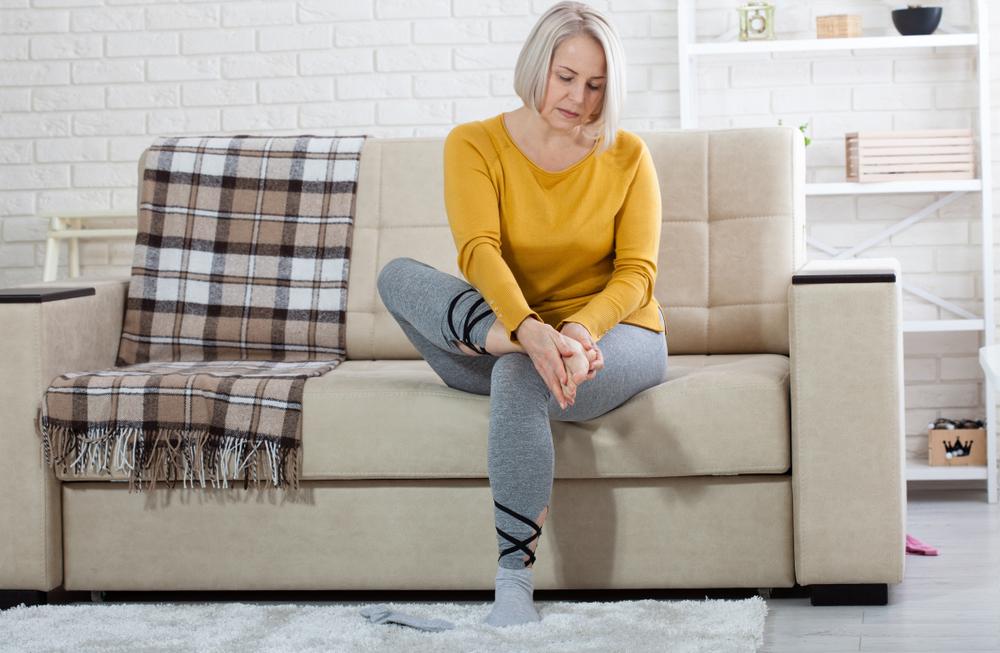Plantar Fasciitis is a very common (and very uncomfortable) condition in the foot. It causes pain and swelling and can impact how and how much you walk. Luckily, there are ways to treat the condition without surgery. But the quicker you spot it and address it, the better.
WHAT IS PLANTAR FASCIITIS?
Plantar fasciitis occurs when the thick, web-like ligament joining your heel to the front of your foot becomes inflamed and painful.
The plantar fascia ligament is responsible for shock absorption and supporting your arch as you walk. As you can imagine, it's subjected to a lot of stress as you go about your day, causing wear and tear.
As damage to the ligament builds up, inflammation and discomfort around the heel increase. Unfortunately, the exact cause of plantar fasciitis is unknown, but it is believed to result from poor biomechanics and slow ligament healing.
WHAT DOES IT FEEL LIKE?
Plantar fasciitis feels like a dull ache or sharp pain in the bottom of the foot near the heel. It is often strongest after exercise, standing for a long period, or walking after an extended rest period. You may also find it challenging to go up and down the stairs due to heel stiffness.
It’s most often described as an aching or burning sensation and can cause some swelling of the heel.
WHAT CAUSES PLANTAR FASCIITIS?
Plantar fasciitis usually occurs in just one foot but can affect both. It will develop gradually as you overuse or overstretch the plantar fascia ligament. In some cases (though rare), it may result from an acute injury - a small tear to the ligament.
There is a range of issues that increase your chances of developing plantar fasciitis, as well as activities that are more likely to cause it.
- Anyone between 40 and 70 is at a higher risk of developing it, especially if you lead an active lifestyle.
- It is generally more common more common in women than men.
- Being overweight or obese increases the pressure on this ligament, and sudden weight gain is especially likely to inflame it.
- Long-distance running and professions that keep you on your feet and moving a lot.
- Pre-existing foot issues like flat foot, high arches or Achilles issues
- Tight foot or leg muscles
- Pregnancy (especially in the third trimester).
- Wearing shoes with little or no arch support or rigid stiff soles.
Plantar Fasciitis can come and go. And unfortunately, once you develop it the first time, you’re more likely to get it in the future.
Fortunately, though, there are several ways to relieve the pain and speed up your healing, minimising the chances of recurrence.
To help you out, we’ve outlined a few of those that are more successful. It’s important to note that in cases where the pain is constant or severe, it’s best to see your doctor.
HOW TO TREAT PLANTAR FASCIITIS
The good news is that conservative therapies work in 70-80% of plantar fasciitis cases.
RICE
The go-to rest, ice, compression, and elevation method can provide temporary relief and help your plantar fascia heal.
PHYSIOTHERAPY
Seeking the assistance of a physiotherapist is often a great way to treat plantar fasciitis and the pain it causes. They’ll be able to improve your mobility manually and recommend an exercise program for you to do at home.
EXERCISE
Doing targeted exercises and stretches will improve mobility and strengthen the muscle surrounding the ligament, taking some pressure off it. Some good exercises to try include:
- Calf stretches
- Rolling stretch (with golf or tennis ball)
- Foot flexes
- Towel curls
- Plantar stretches
WEARING INSOLES

ErgoPad Redux Heel 2
Wearing insoles or orthotics is an effective way to manage the condition, as you can wear them over the day to treat the condition while you work, alleviating the pain and soothing the ligaments.
The ErgoPad Redux Heel 2 is a good fit here. It will help improve the natural roll of your foot while relieving pressure and pain. Its slim and flexible design also means it can fit into virtually any shoe.
NIGHT SPLINTS
When we sleep, most of us unconsciously have our toes pointed downwards, which puts pressure on the ligament, aggravating plantar fasciitis.
By wearing specially fit splints, you keep the foot in a posture most suitable to the recovery of the foot, allowing for support overnight. Combining this with insoles, physiotherapy, and sufficient rest will give you the best chance at recovery.
If you require assistance selecting the right product for your needs or wearing the brace, call us on 098015660 or contact us via live chat.
Do you have private health? Most private health extras will cover Bauerfeind Products. Check to see if yours is included. Bauerfeind Private Health Insurance Inquiry.
















